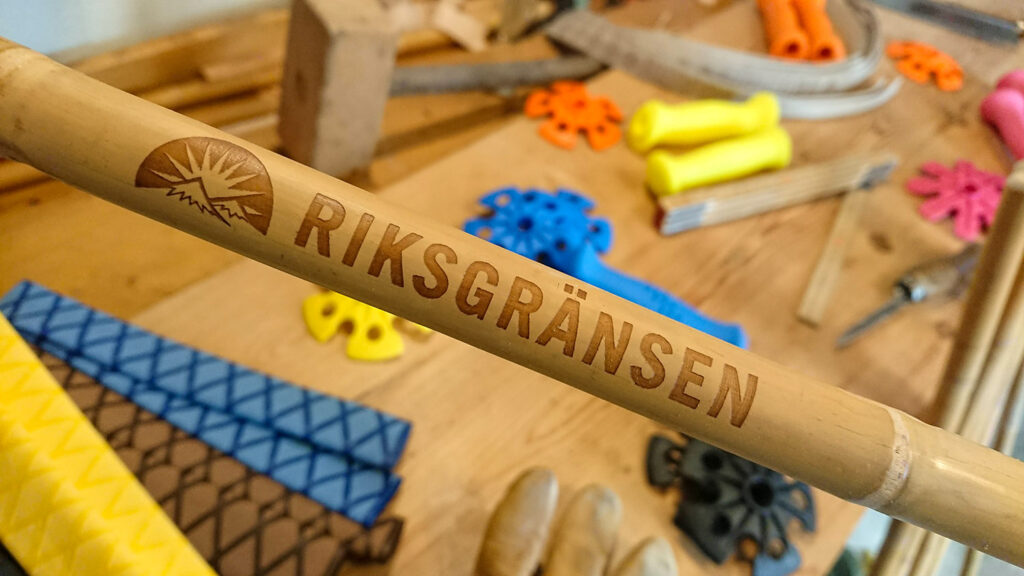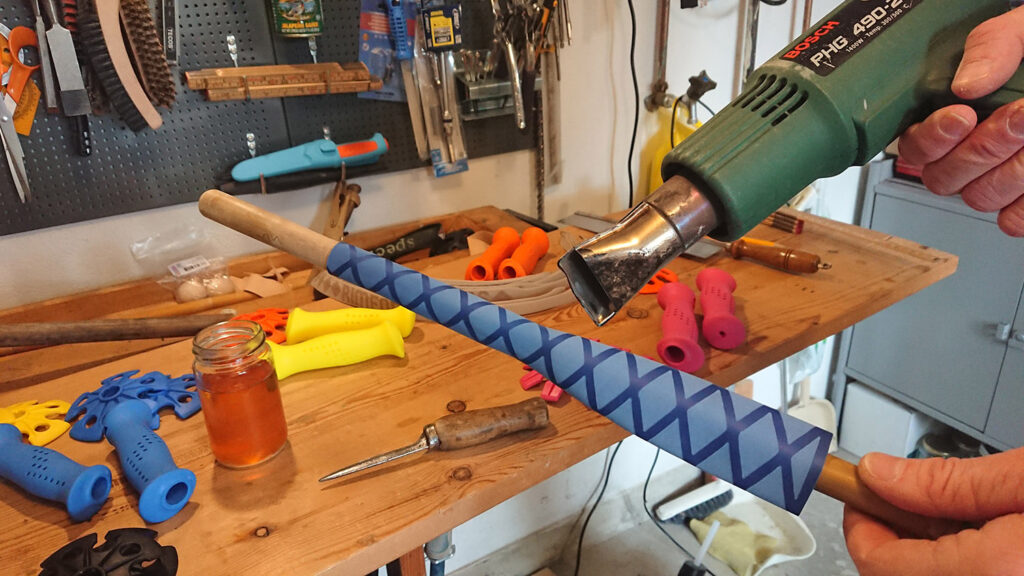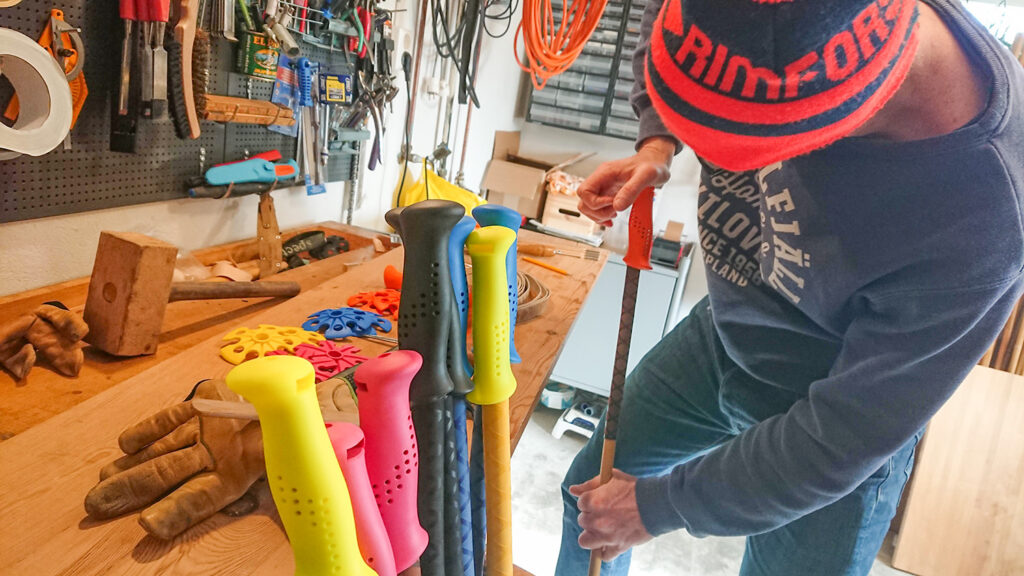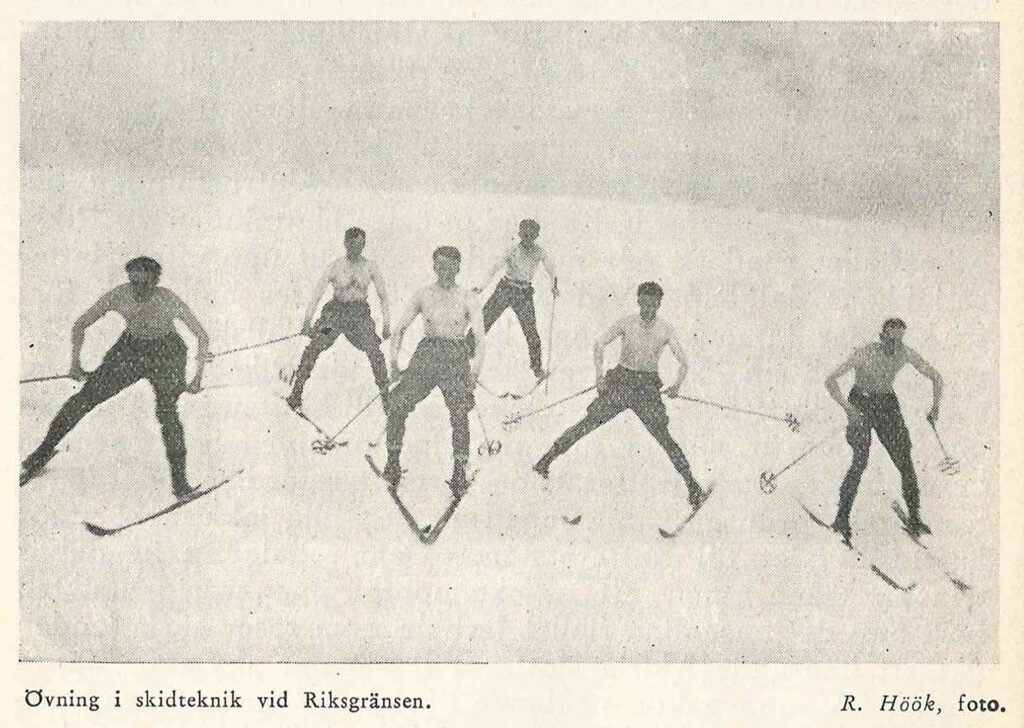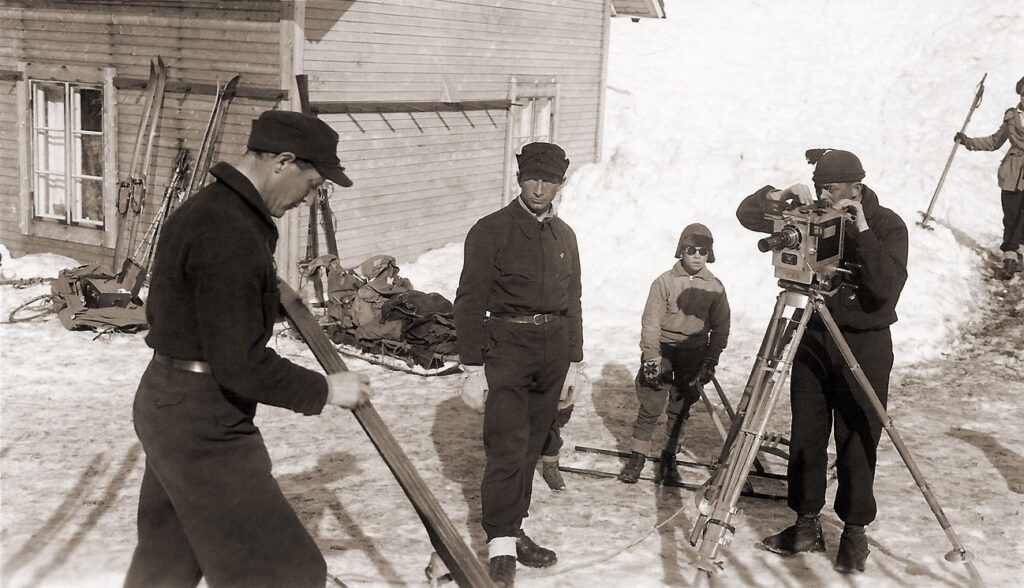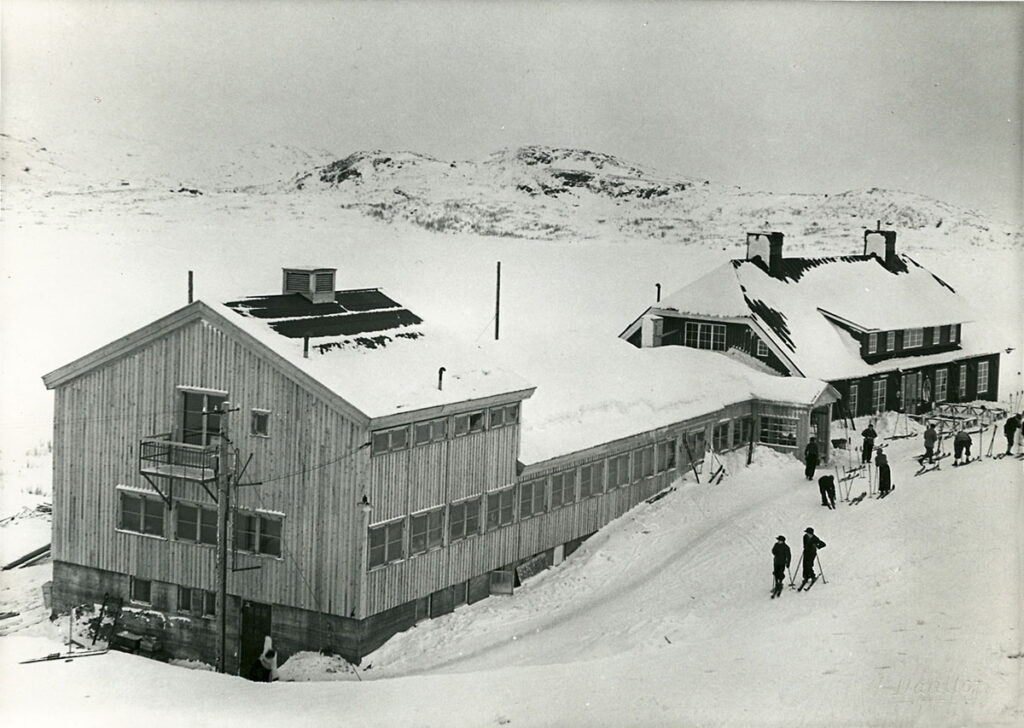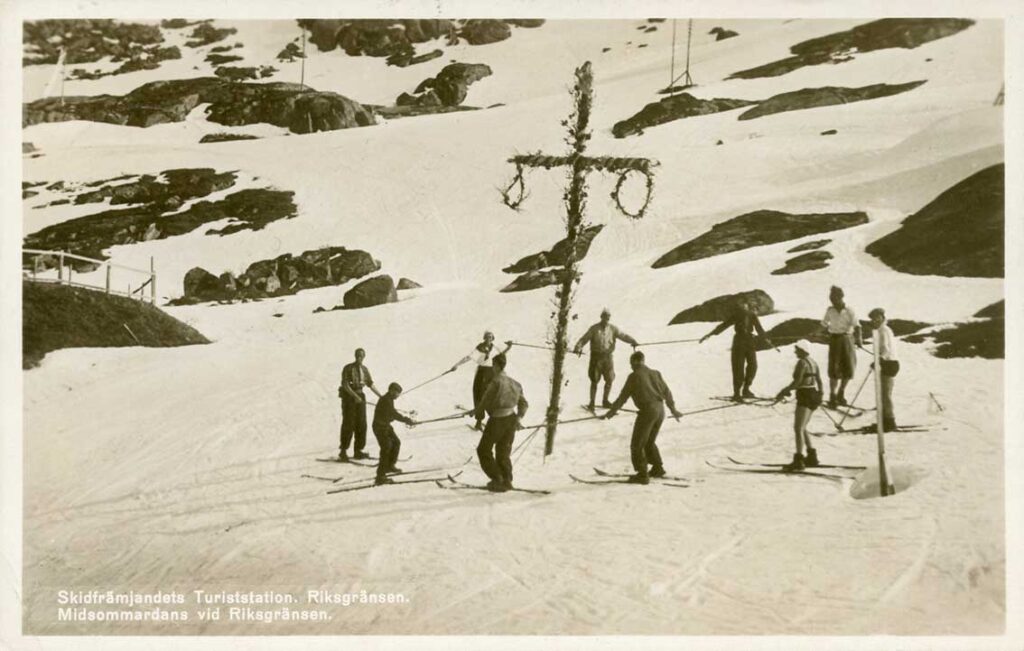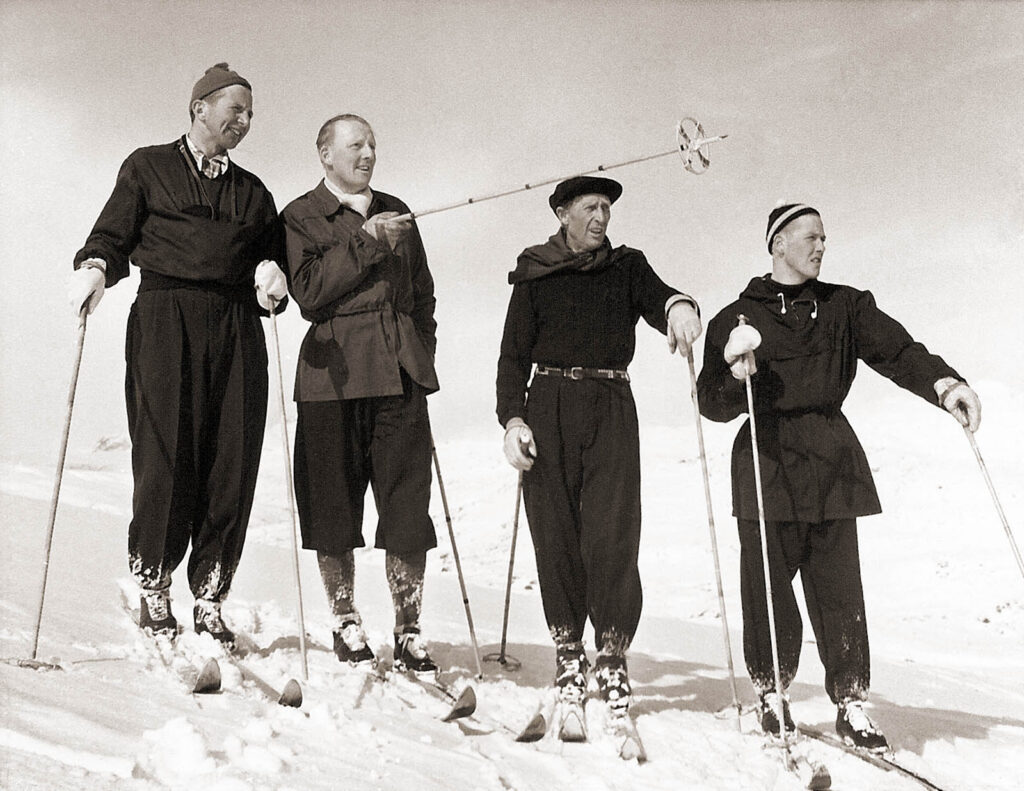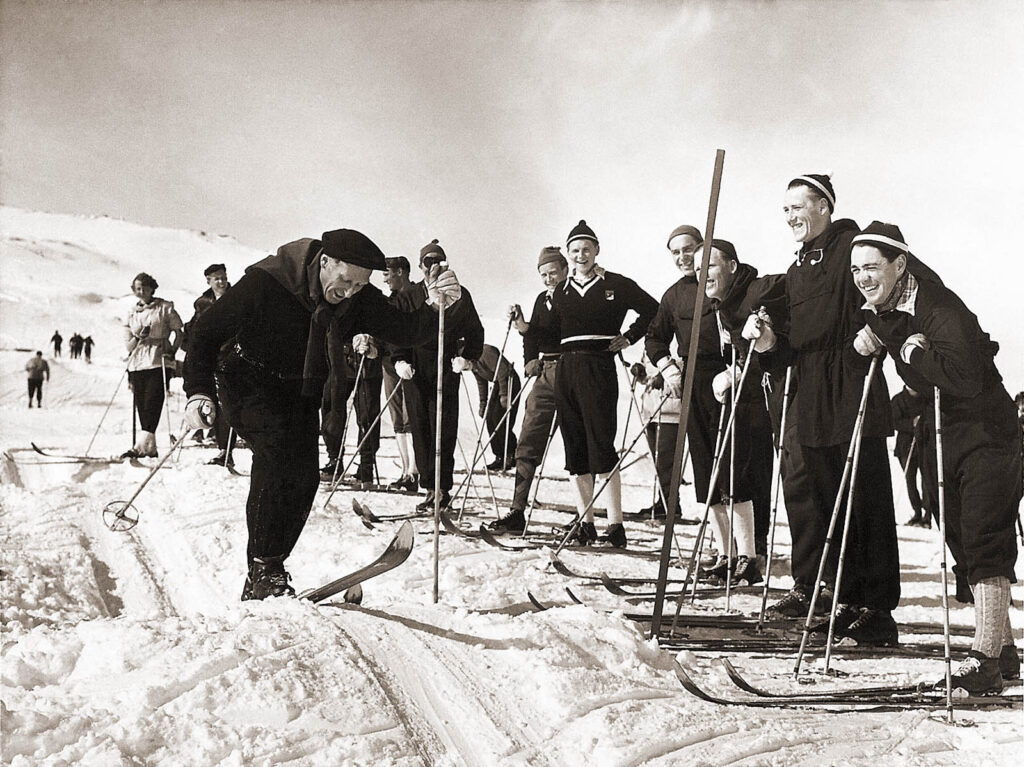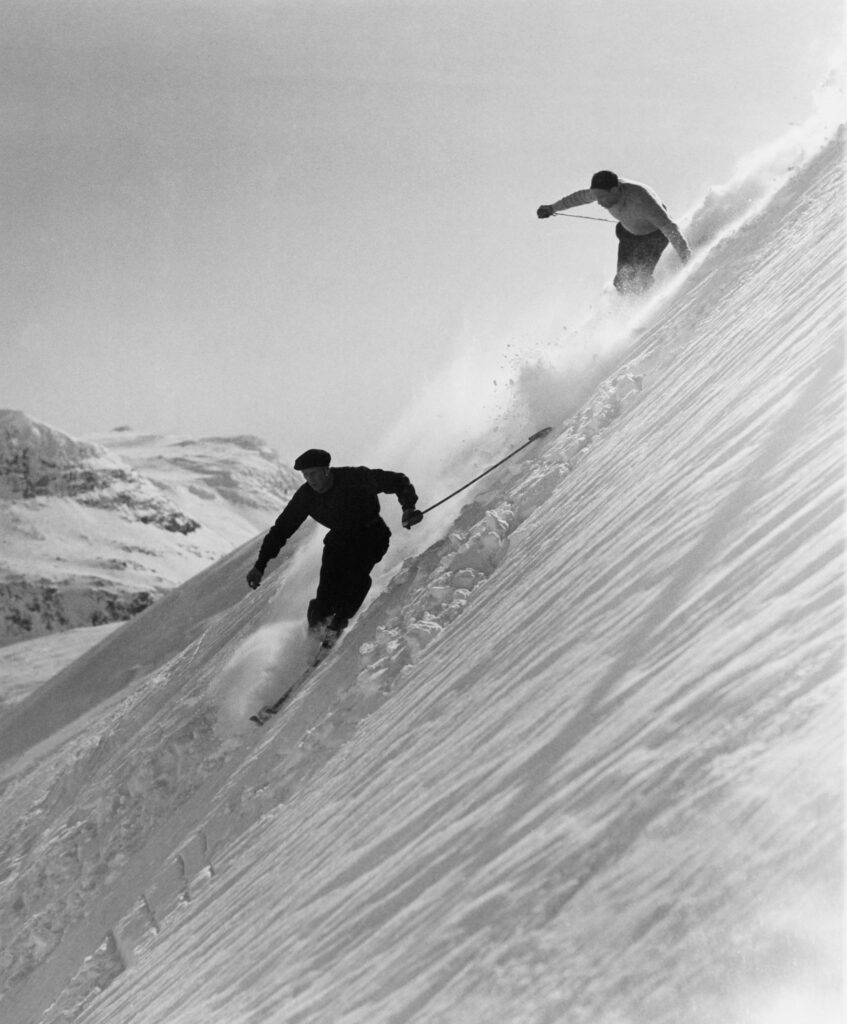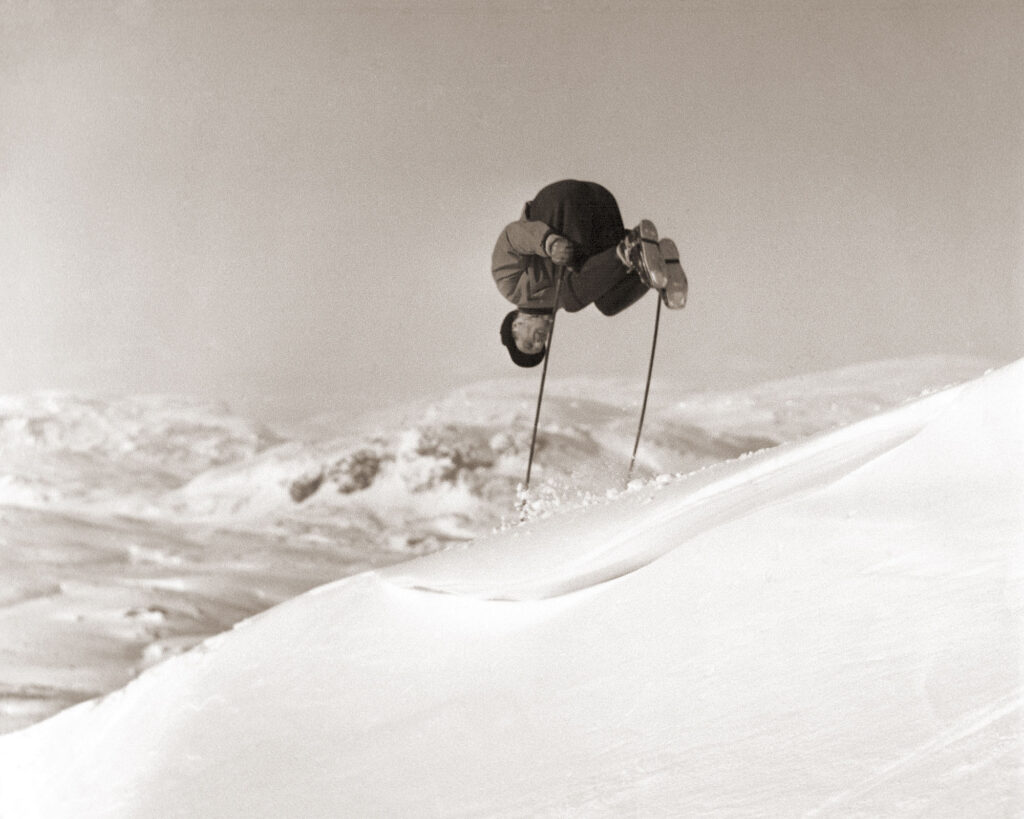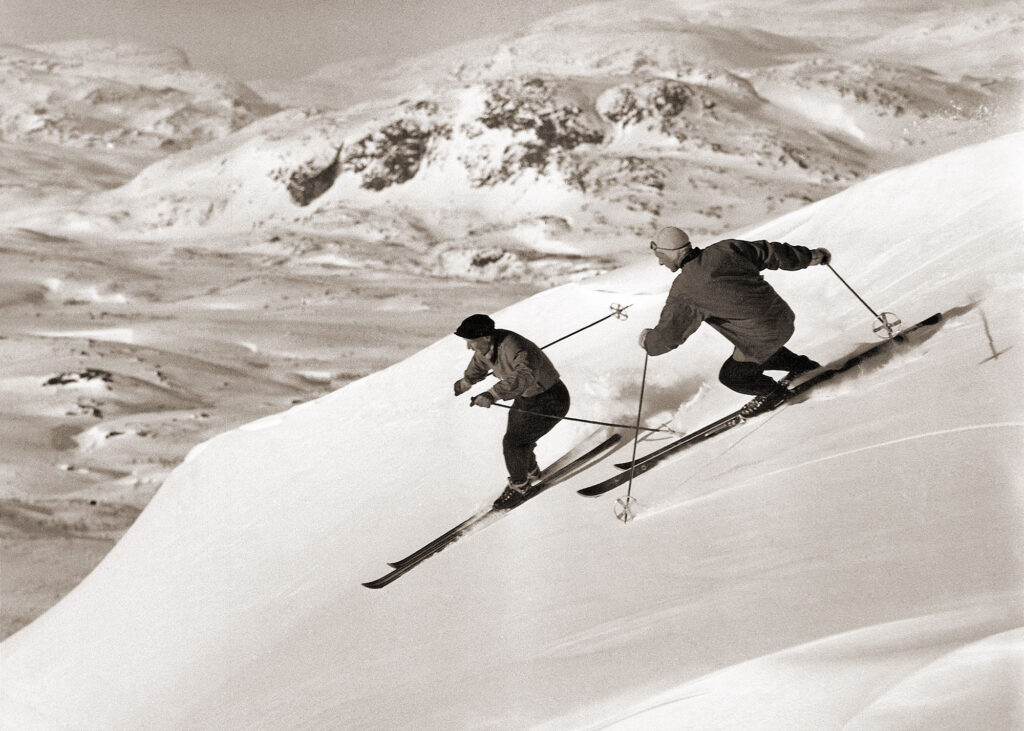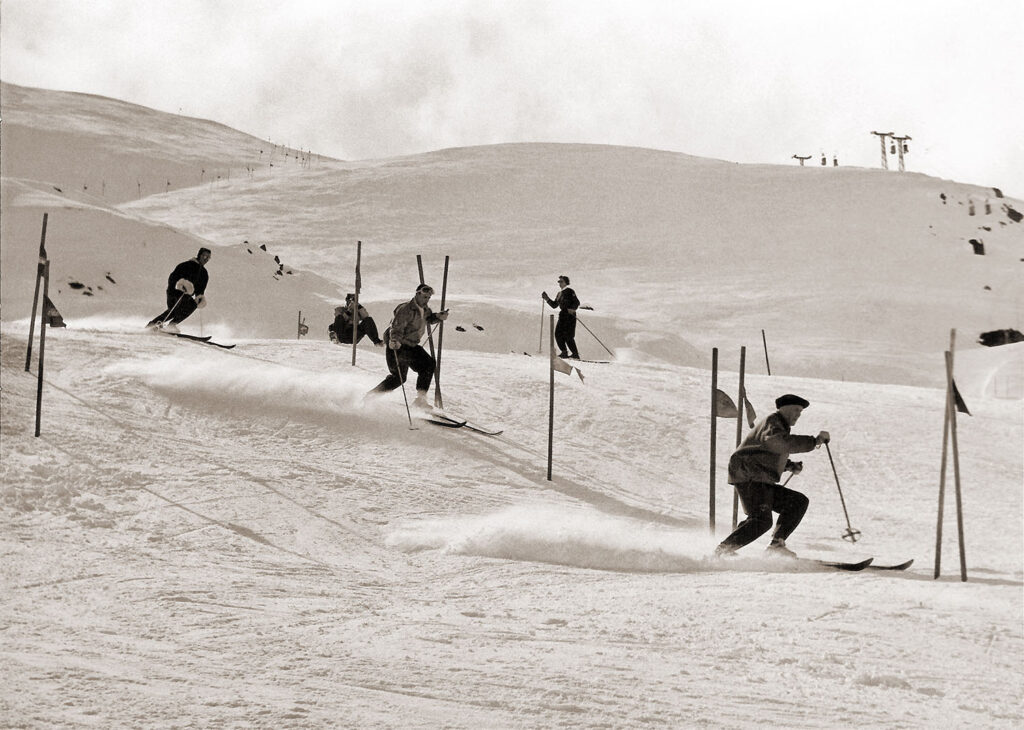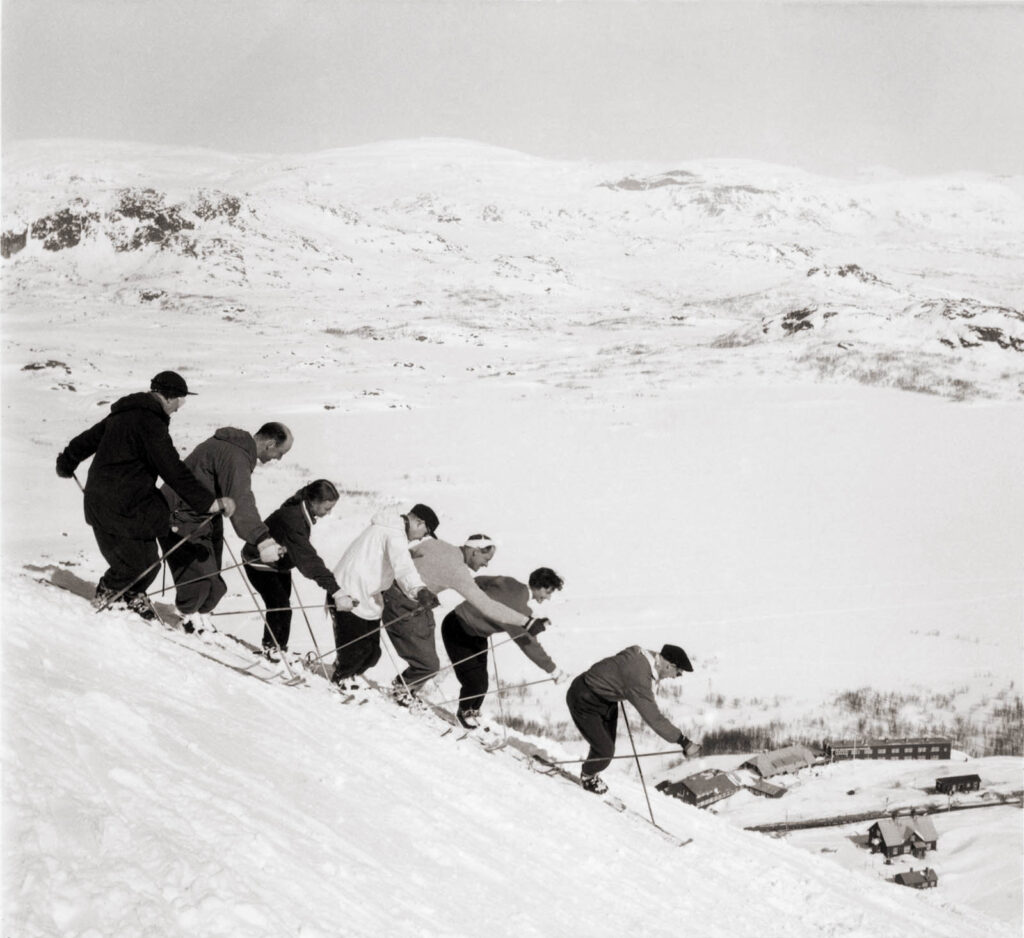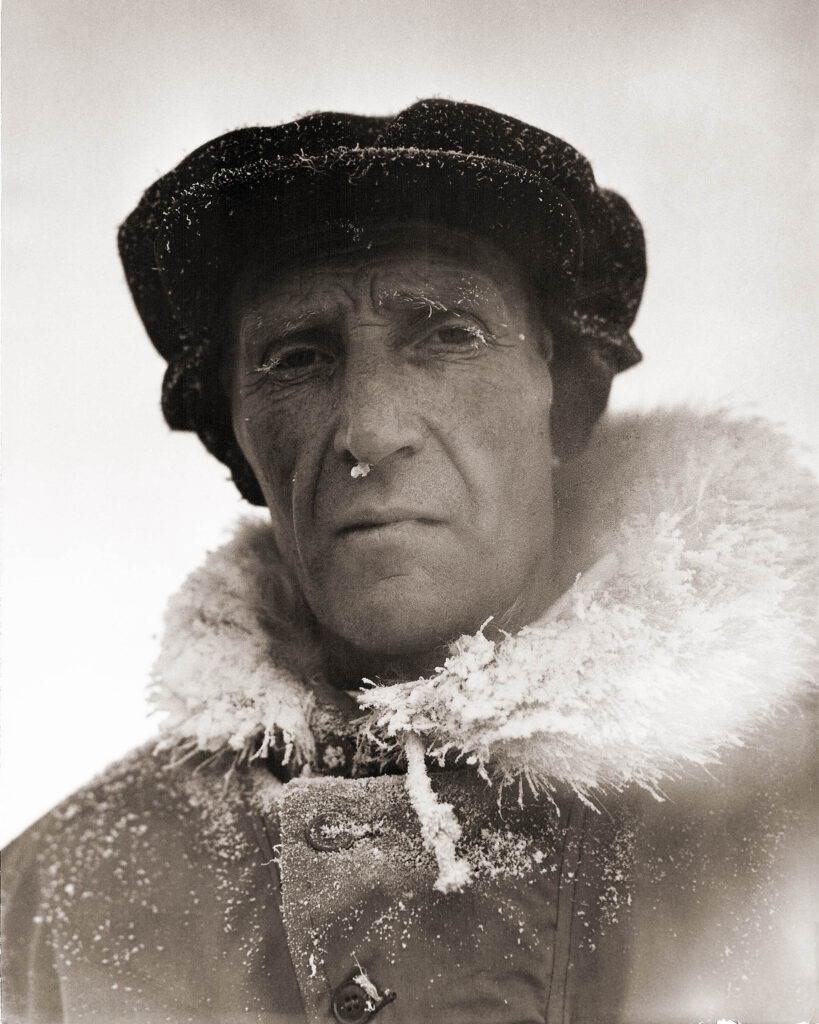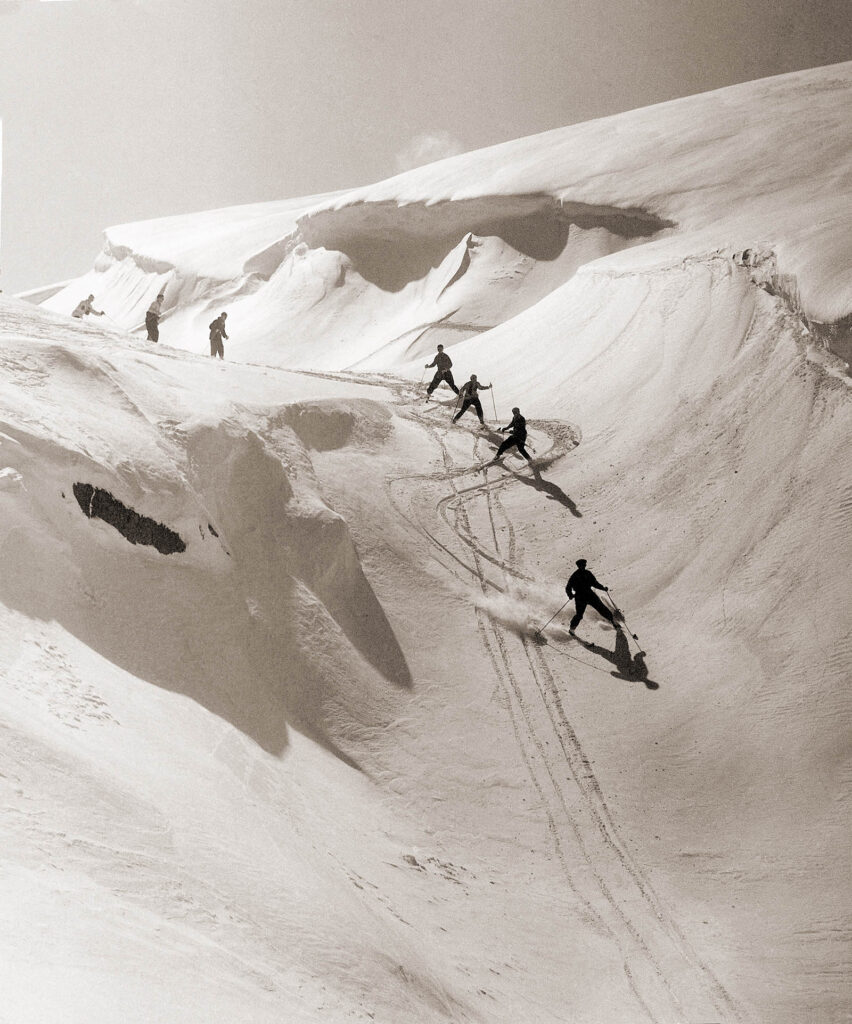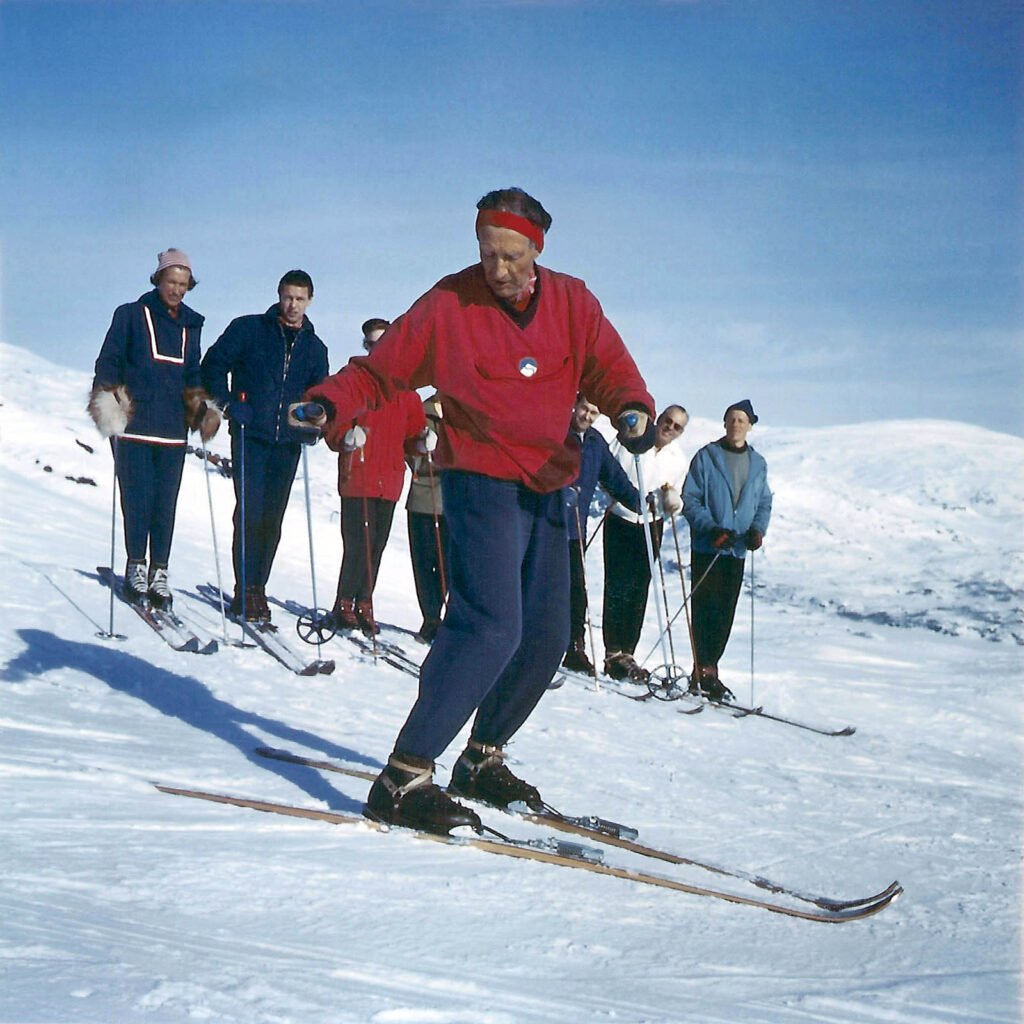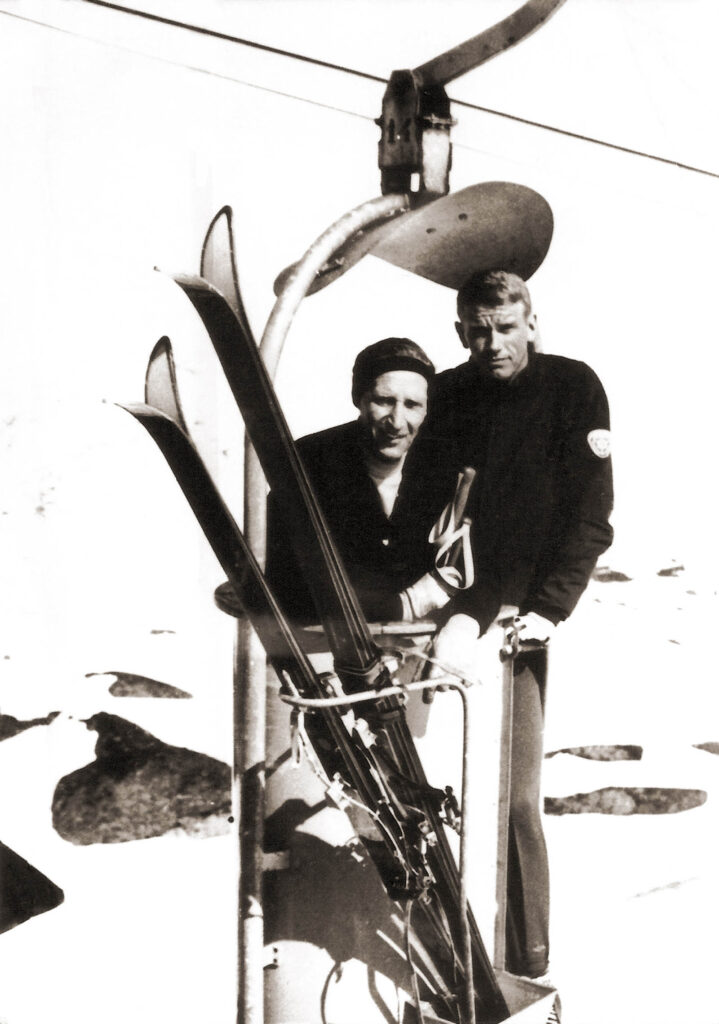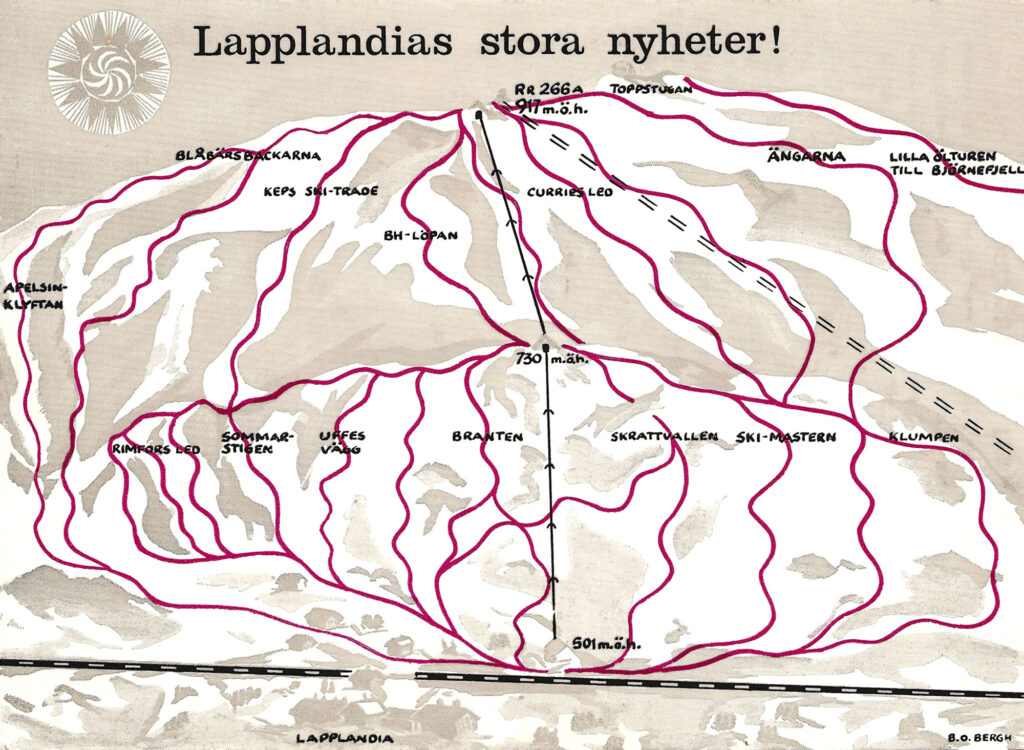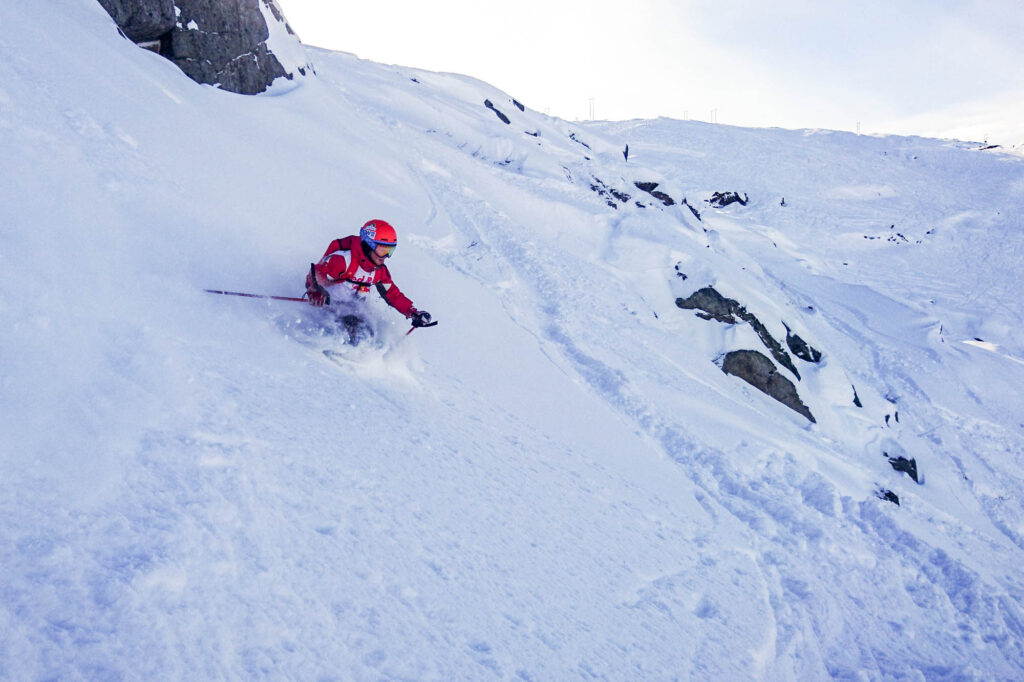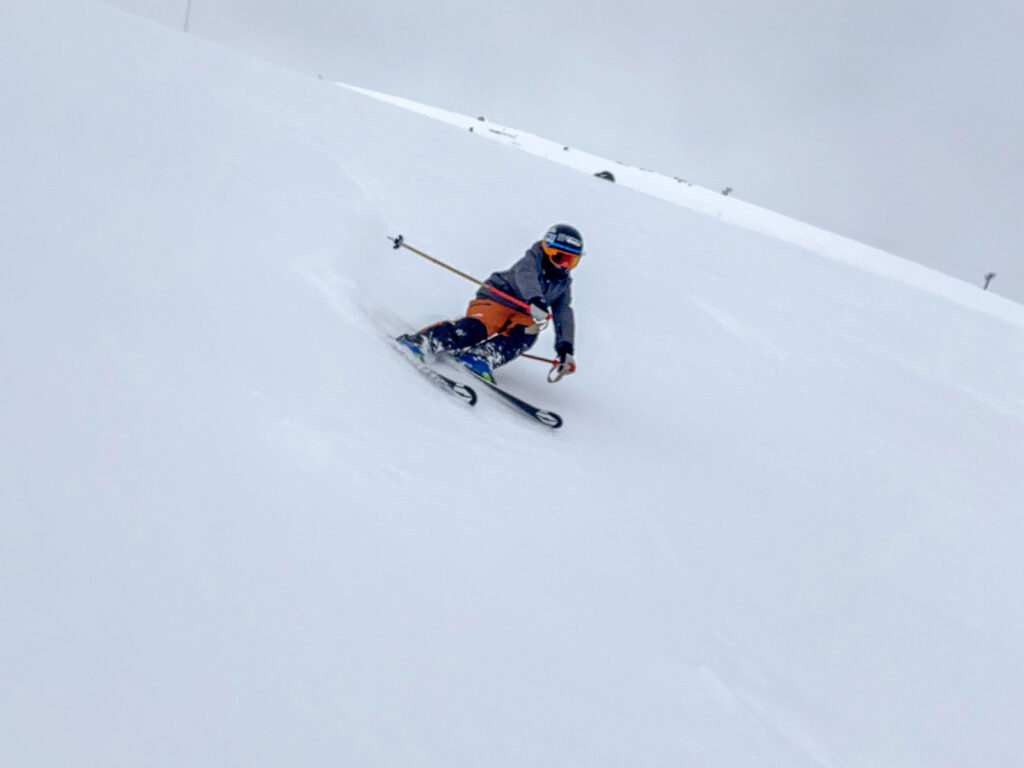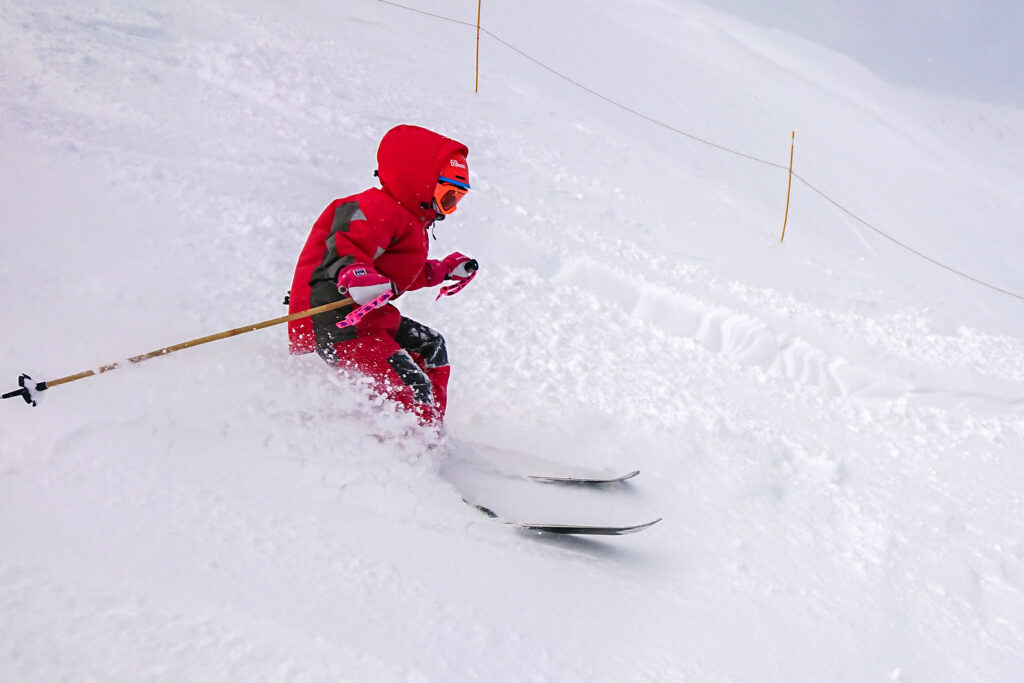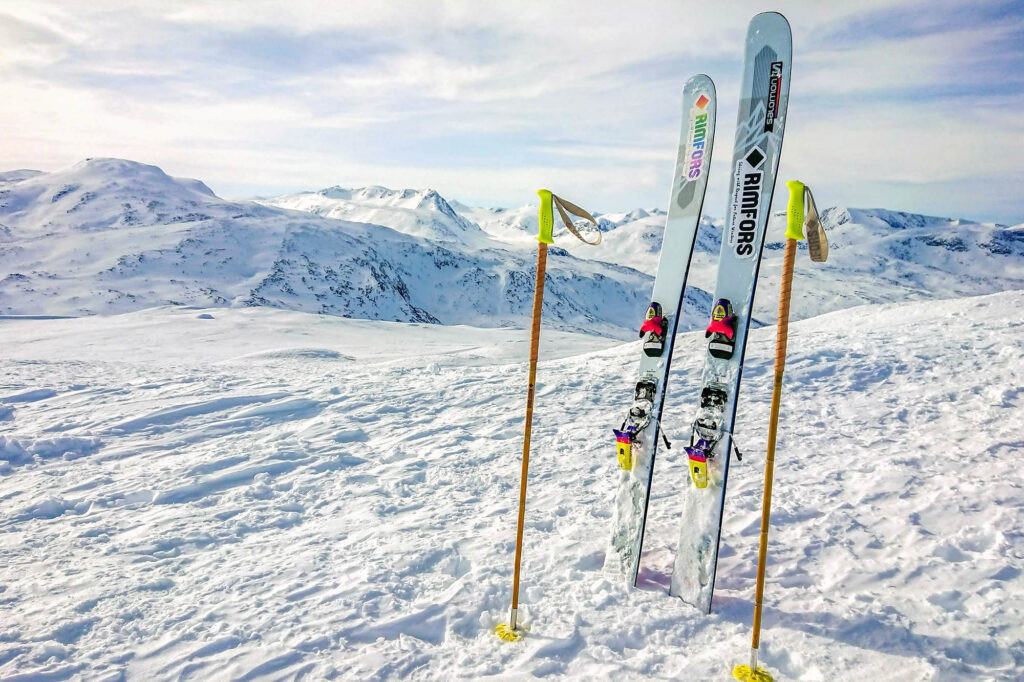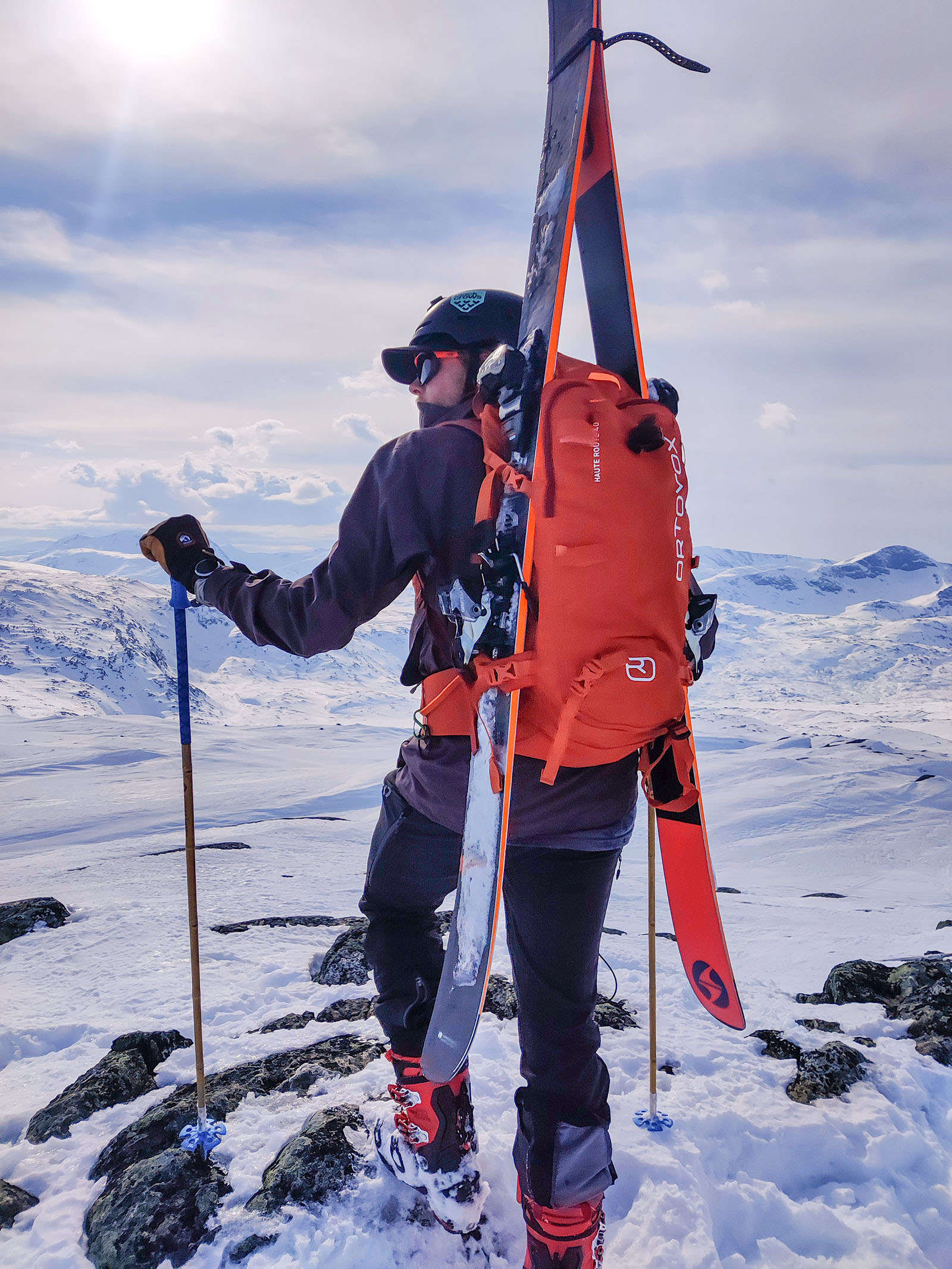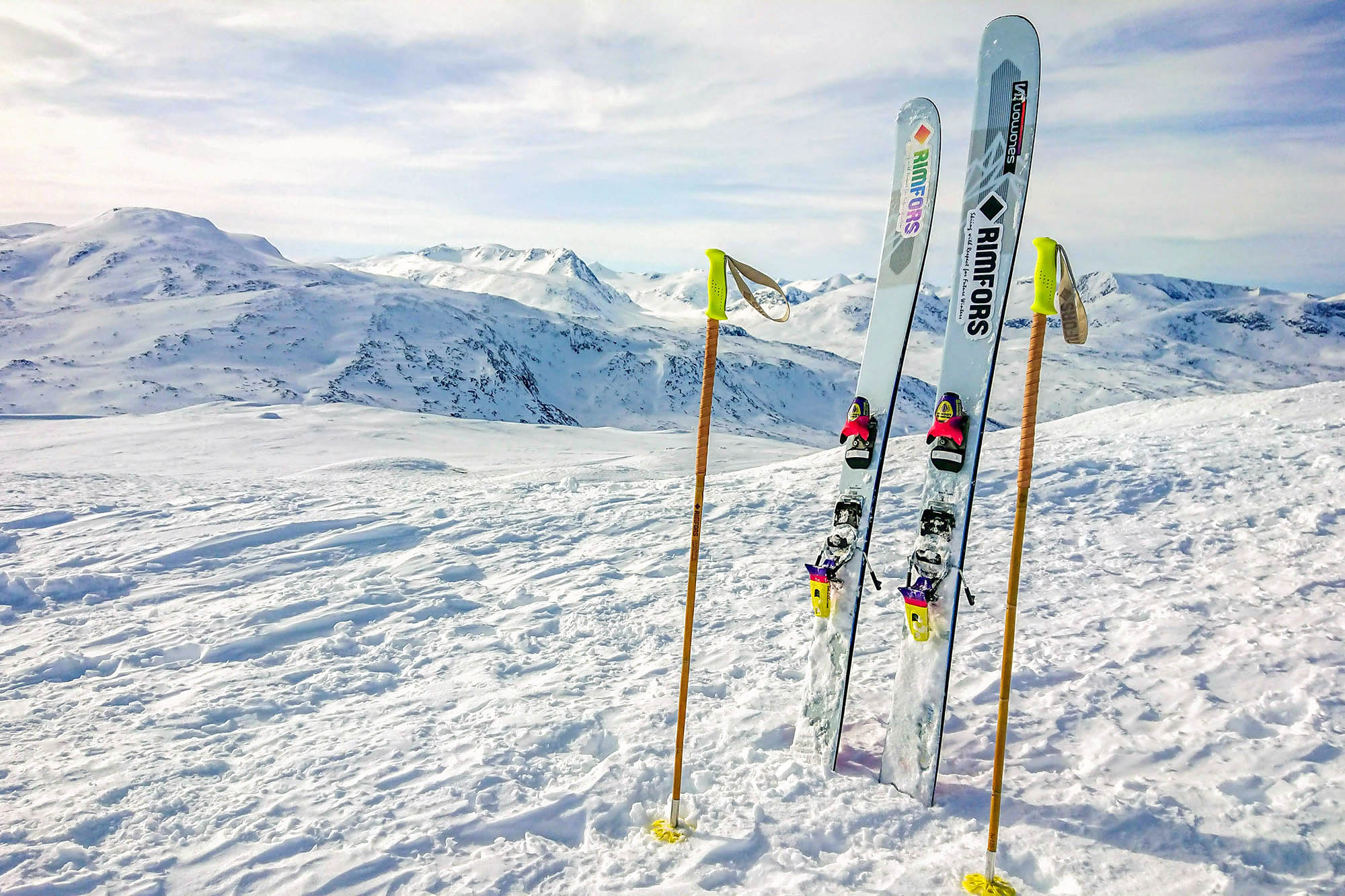Riksgränsen. Few places have the same mythical appeal to skiers as Riksgränsen. This magical mountain and powdery paradise right on the national border—far, far north into the Arctic. More snow falls here than anywhere else in the country. Here you can find big mountain skiing easily accessible. You can ski in the midnight sun until midsummer, turn left into Norway and then right back to Sweden.
The variety in the terrain is outstanding. Just point your skis in the direction you want to go and take off. Cornices, cliffs and curves make each ride unique and transform the Riksgränsfjället into a gigantic playground for people with skis and snowboards under their feet. And there is not just one, but several majestic mountains right around the corner. No wonder that Riksgränsen usually is voted “Sweden’s best off-piste mountain”.
Excuse me Åre! The cradle of Swedish alpine skiing is in Storlien, Östersund and Riksgränsen. Storlien was certainly the flagship when Skidfrämjandet started promoting skiing downhill, but Riksgränsen was the “crown jewel”, as my great-grandfather, ski pioneer Olle Rimfors, used to say. In Åre, tourists went tobogganing and curling.1 In Riksgränsen they went skiing.
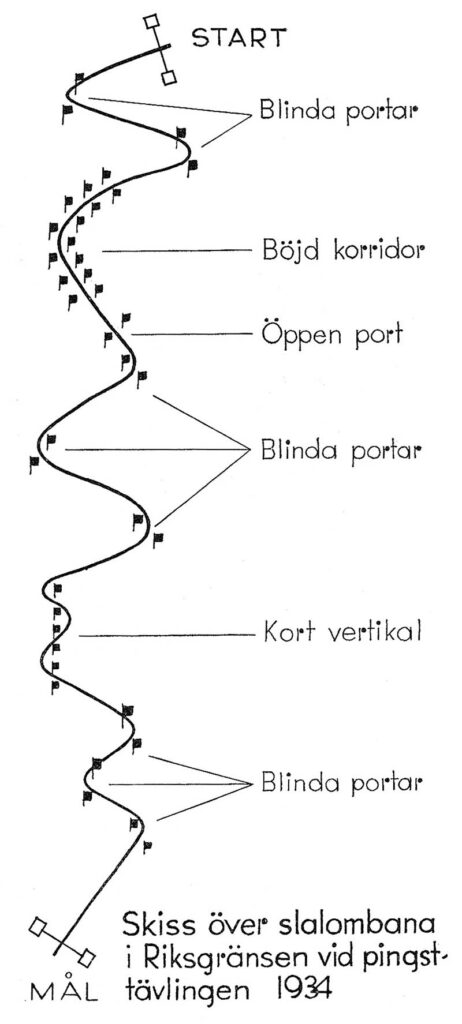
Sweden’s first alpine ski race—in slalom and downhill at Riksgränsen
On Easter Monday 1929, during morning exercises, Sweden’s first “slalom course” was set at Riksgränsen.2 Admittedly, this was hardly any regular slalom race. However, it was indeed five years later, during the Pentecost weekend. Ivar Holmquist had decided to organize Sweden’s first alpine ski race at Riksgränsen, open to the public as well as to foreign skiers, making it international. He was then colonel and brigade commander at the Northern Army Division, but also chairman of Skidfrämjandet and president of the International Ski Federation, FIS.
The alpine race at Riksgränsen was part of popularizing the new sport, which had been criticized for, among other things, being “a sport for playboys” and “too much fun and not enough hard work”. Whit Monday, May 21st in 1934, is thus the first time we really race in slalom and downhill in Sweden.3
My great-grandfather and his buddy Sigge Bergman had recently been down to Hannes Schneider in St Anton am Arlberg, Austria, and learned the latest alpine skiing methods, the Arlberg technique. It was a ground-breaking trip for Swedish alpine skiing that changed everything.4 Ivar Holmquist was my great-grandfather’s boss and good friend and had sponsored Olle and Sigge with SEK 150 each to bring home as much knowledge and experience as possible. During their two month journey in the Alps, they represented Sweden at the FIS Alpine World Championship in St Moritz, Switzerland. That’s where they learned the FIS rules, from the man who wrote them, Sir Arnold Lunn.
Sweden’s first international alpine ski race
The Pentecost race at Riksgränsen had also been licensed by the Swedish Ski Association, which had previously refused to have the alpine disciplines on the program during the FIS Ski World Championships in Sollefteå earlier that year. That’s why the slalom and downhill race had been held in Switzerland, although still under the Swedish flag.
Ivar Holmquist had sent invitations to Norway, both to the Norwegian Ski Federation and directly to Riksgränsen’s neighboring ski club in Narvik. However, no Norwegians showed up, but among the 20 participants that Sigge Bergman, the chief of race, welcomed the morning of Whit Monday there was one American, so Sweden’s first real slalom competition was international after all.5
The day began with a downhill race that started at the meteorological outpost at the top of Riksgränsfjället and finished right by the railway. The course measured 1,500 meters and had a vertical drop of 450 meters. Just like in the Alps, Bergman had the participants start at 30 second intervals. A light drizzle made the course very fast for those who had waxed their skis properly, and despite the weather, the race had attracted hundreds of curious spectators from near and far, who cheered on the races. The winner Bertil von Porat crossed the finish line in 1.55.4 minutes. Forerunner Sigge Bergman skied in 1.29.4 minutes. One skier was disqualified for pole riding and the overall impression was that the ski technique of the racers was poor.
The second discipline of the day was the slalom. Sigge had set a course, run twice; 400 meter long with a vertical drop of 125 meters. As forerunner in both runs, he showed the way at a combined time of 1.19.0, a time no one else came close to. His expertise underlined the superiority of the Arlberg technique that Olle and Sigge had just learned in the Alps. Åke Morell from Kiruna won the slalom with a 2.6 second margin, in a time of 1.41.6 minutes. But the big winner of the Pentecost race was Bertil von Porat from Stockholm who took the combined title.
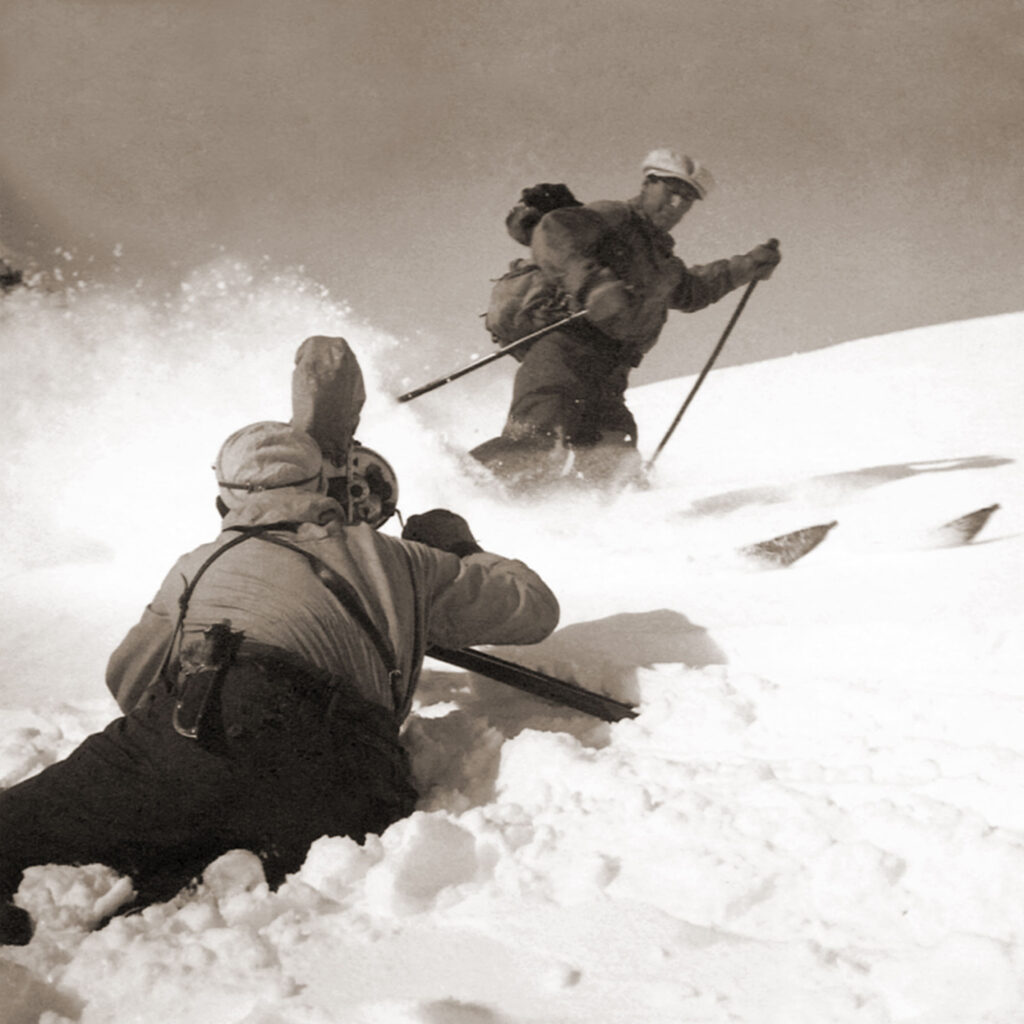
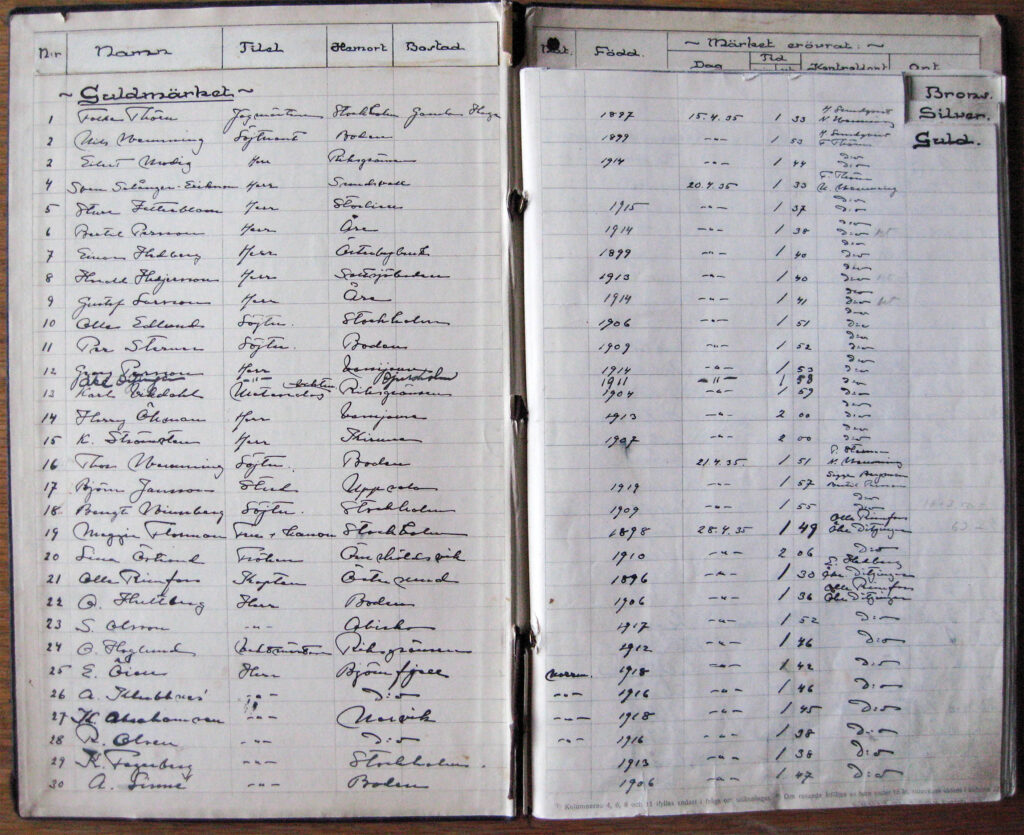
The Riksgränsen downhill badge
Up in the Nurki mini-museum at Hotel Riksgränsen, there is a register book of the Riksgränsen downhill badge (Riksgränsens störtloppsmärke). The badge was instituted at Easter in 1935 to further stimulate interest in downhill skiing among enthusiastic visitors that came to Riksgränsen. If you want to compare yourself against the speedsters of the 30s—the distance is the same as during the downhill race in 1934; start from the very top of Riksgränsfjället and finish one and a half kilometers further down by the hotel.
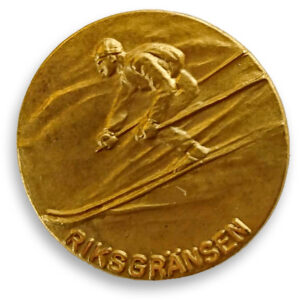
To capture the badge in gold, the requirement for men was two minutes, for silver four minutes, and for bronze six minutes. For women, three minutes applied for gold, four and a half for silver, and eight for bronze.6 In the Downhill badge’s register book, just a week after the badge had been inaugurated, I note my great grandfather Olle, then almost 39 years old, timed at 1.30 minutes.7 Can you beat that with wooden skis and soft leather boots?
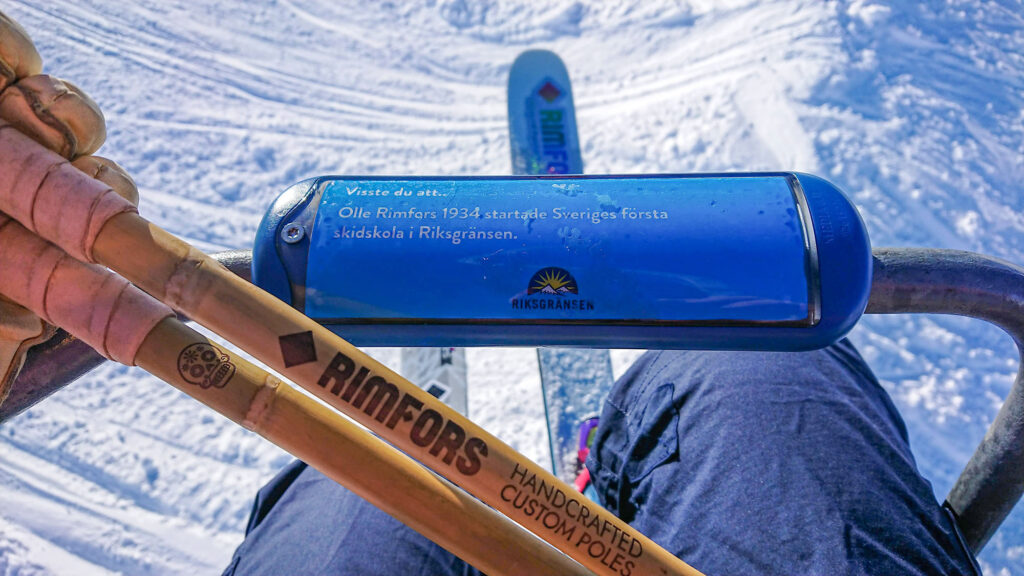
Sweden’s first ski school—at Riksgränsen
In the fall of 1934, they started talking about a Swedish ski school based on Hannes Schneider’s model, which was considered the best in the world. No sooner said than done, between Christmas and New Year 1934, Olle Rimfors and Ivar Holmquist founded Sweden’s first ski school, Skidfrämjandet’s ski school. Since Olle worked as captain at the ranger regiment in Östersund, Sigge Bergman would manage the business. However, Sigge was down at Hannes Schneider’s in St Anton again, so Olle, who as usual taught military ski courses in Storlien, tested the concept there and refined the arrangement.
On April 17th, 1935, just in time for Easter, Sigge was back in Riksgränsen together with Olle, who was there shooting the epic ski film Igloo. Sweden’s first ski school could open officially.8 A full day class cost three Swedish kroner and for that you got four hours of instruction, two in the morning and two in the afternoon. Students flocked from near and far, even as far away as the United States and Mexico.9
When the ski school closed on June 15th, around 700 guests had taken ski lessons. The following season, Skidfrämjandet counted over 6,100 students, of which 4,600 had taken instruction at Storlien and 1,500 at Riksgränsen, where the season ended abruptly by the end of May, due to unexpected heat and lack of snow.10 The third season was delayed due to lack of snow at Storlien, but resulted in over 5,350 students, of which 2,166 at Riksgränsen.11 Nothing else than a big success.
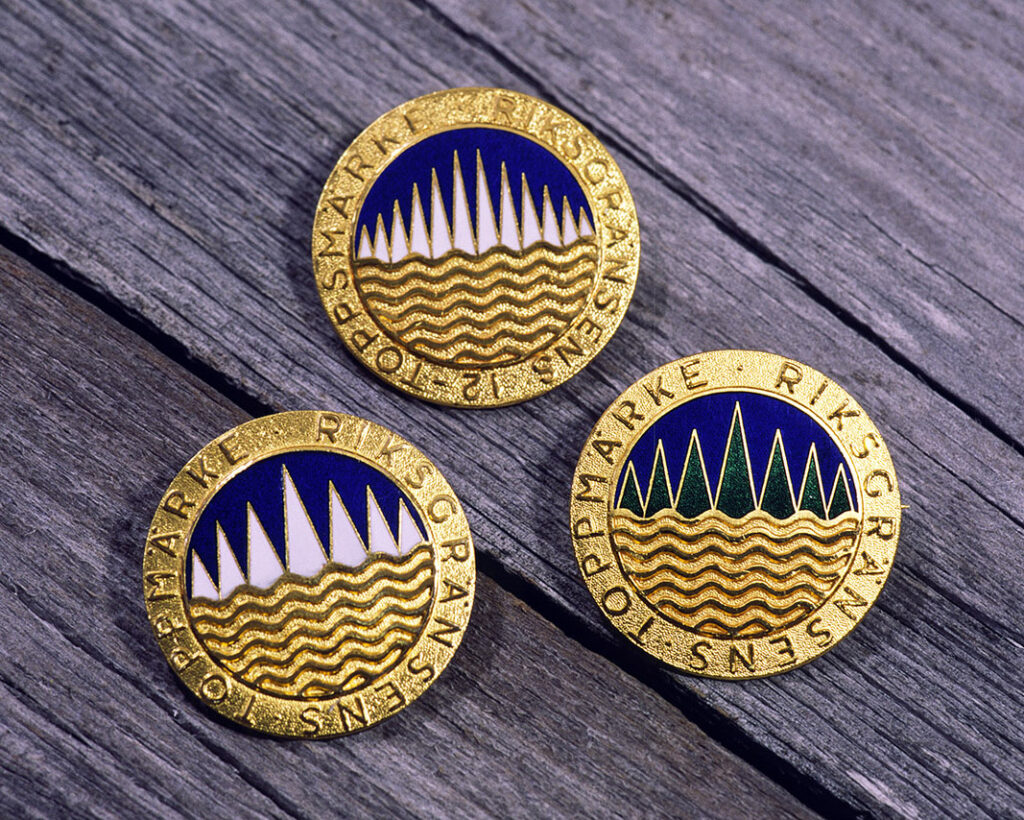
Seven summits at Riksgränsen
What did people do in Riksgränsen when it opened for the first time in 1928, before we had alpine skiing in Sweden? Well, you went ski touring. Riksgränsen’s train station is 521 meters above sea level. No wonder Skidfrämjandet picked this place. Nowhere else in Sweden is winter as present and the mountainous smorgasbord such a short walk from the platform. And trains were then as now the most convenient means of transport.
What further sets Riksgränsen’s platform apart from all others is that you get off the train at the doorstep of the hotel, from which you easily access lots of mountains. Quite naturally, the Riksgränsen “Seven summits badge” (Riksgränsens toppmärke) was invented. It was founded on May 20th, 1943, by three regulars who wanted to “welcome all true mountain lovers to the sporty, interesting and perhaps even exciting and strenuous ski tours, which will take You far into the wonderfully beautiful mountain world of Riksgränsen and at the same time give You versatile opportunities to acquire the qualifications that distinguish a skilled, persistent, and experienced skier and mountaineer”.12 Skidfrämjandet soon realized that the badge was an excellent incentive for guests to return to Riksgränsen, to “conquer” more summits for a badge, so just two years later they took over the administration of the badge.
Criteria for the Riksgränsen summit badge
To obtain the badge, you would go ski touring with one of the guides and summit a number of peaks in the vicinity of the hotel. Only one summit was accounted for per trip, and only with skis. It wasn’t a summer trekking badge! Once back at the hotel, the mountain guide indexed you in a register with information about who had summited which peak and when. When you summited seven of the 19 peaks enumerated in the badge’s statutes, you were entered in the “Summits badge book” (Toppmärkesboken) and you could buy the coveted Seven summits badge for five Swedish kroner.13 All but one peak measures at least 1,300 meters.
In the early 1970s, the Seven summits badge was complemented with the Twelve summits badge. And in 1996, an addition was made to the statutes because the road to Riksgränsen, which was completed in 1984, had enabled more peaks. The ski touring area was expanded to 90 km in an east-west direction and 60 km in a north-south direction, and now even lower peaks were approved, as long as there was an 800-meter climb to the top.14 At the moment, the summit badges lie fallow, but perhaps they will come to life again on a shiny winter’s day. Together with Abisko and Björkliden, Riksgränsen has been voted “Sweden’s best ski touring area” several times. A more worthy place for summit badges is hard to find in our elongated country.
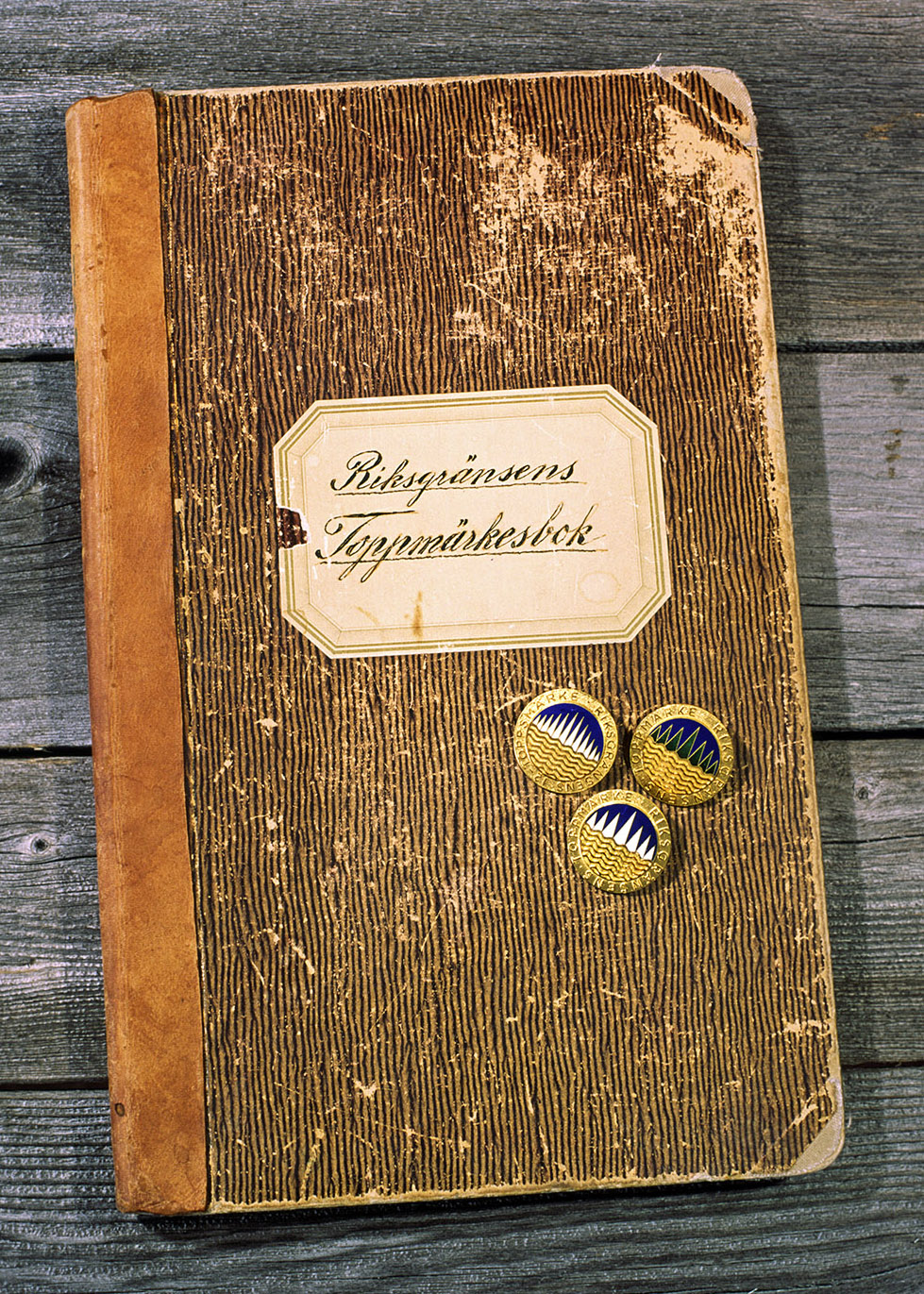
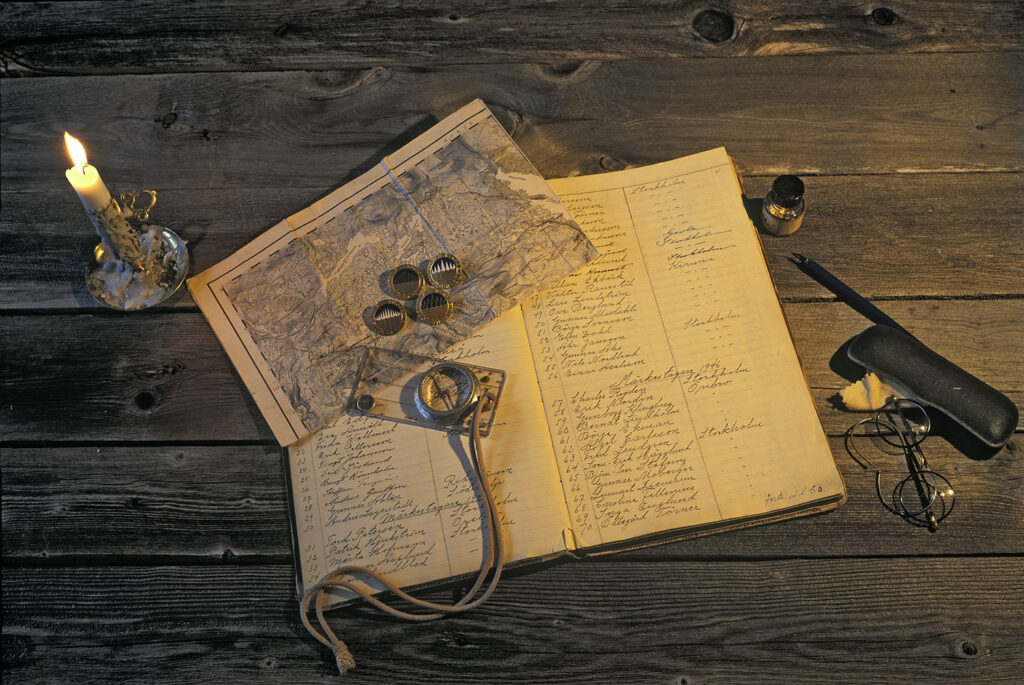
* * *
Branded ski poles with custom engraving
When Olle Rimfors retired from the military in 1950, he became head of the Skidfrämjandet ski school at all their major ski resorts, which then included Sälen, Storlien, Hemavan and Riksgränsen. He started the season with fresh snow in the south and finished in the midnight sun in the far north. Riksgränsen was his obvious favorite, even though he and several others had wished that the hotel was on the “sunny side” of the mountain, at Katterjåkk. He continued as head of the ski school until 1966, when he retired at the age of 70. Both Olle and several of his ski instructors have slopes and runs named after them. The off-piste run Rimfors is of course a family favorite.
Riksgränsen continues to make ski history. International competitions like the Scandinavian Big Mountain Championships, King of the Hill, and Riksgränsen Banked Slalom, are excellent examples of that. Just before Easter I got an order from the owner of this historic resort. To manufacture ski poles with the Riksgränsen logo as custom engraving is, for me, a great honor. It feels special and comes full circle. In 1928 Skidfrämjandet’s tourist station opened in the old, decommissioned railway barracks, on Ivar Holmquist’s initiative.16 90 years ago, people skied with Rimfors poles in Riksgränsen, my great-grandfather’s original version with a big basket and leather grip. Now the Rimfors poles are back where they belong, albeit in a new version, but still bamboo. It warms my skier heart!
/Fabian Rimfors
P.S. Thanks a lot for the photos Lars Thulin!
References
Here you find further reading about the Pentecost race, ski school, badges, etcetera.
1 Olle Rimfors skidfärd, Med hin håle i hasorna, s 138, by Fabian Rimfors
2 På Skidor 1930. Skidlöpning i Riksgränsfjällen [”första Slalom-tävlingen i Sverige”], s 32f, by Robert Höök
3 På skidor 1935. Sveriges första internationella utförstävlan i Riksgränsen, s 392ff, by Sigge Bergman
4 Mot avgrunden med snälltågsfart, Dagens Nyheter, January 31st, 1934
5 Rapsodi i Riksgränsen: Linbana eller spårvagn till toppen, Friluftsliv o motionsidrott, May 25th 1934
6 På Skidor 1938. Sveriges första SM i slalom, s 234f, by Ivar Holmquist
7 Störtloppsmärket: Skidfrämjandets turiststation Riksgränsen, s 1ff
8 På Skidor 1936. Skidfrämjandets skidskola, s 76ff, by Sigge Bergman
9 Tankar på tåget. Riksgränsvinter – Stockholm…, Friluftsliv och motionsidrott, June 7th, 1935
10 Svensk skidkalender 1937, Skidfrämjandets skidskola – vintern 1935—36, s 149f, by Sigge Bergman
11 Svensk skidkalender 1938, Skidfrämjandets skidskola år 1937, s 90f, by Åke Ditzinger
12 Riksgränsens toppmärkesbok, 1943, by Artur Kallberg, Sten Törnqvist och Nicke Johannsen
13 Skid- och friluftsfrämkandets kalender 1949, Riksgränsens toppmärke, s 137ff
14 Topptur, Riksgränsens topptursmärke, s 30, by Mikael af Ekenstam, Lars Thulin and Mikael Engblom
15 I Riksgränsvimlet, Svenska Dagbladet, May 5th, 1951, av Chevalier
16 På Skidor 1929. Riksgränsen, ett eldorado för skidlöpare, s 34ff, by Ivar Holmquist
More Riksgränsen historiy can be found at www.riksgransen.se/en/!
